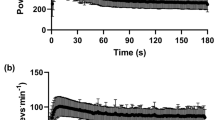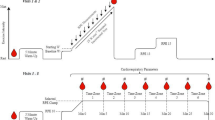Abstract
Purpose
The constant work-rate to exhaustion tests must be repeated several times at each work-rate to estimate subject-level trial-to-trial variance (intra-individual variability, IIV) of critical power (CP) and work capacity (W'). Alternatively, these parameters and their variance can be estimated by repeating the 3-min all-out test (3MT) fewer times. The purpose of this study was to propose a method to determine subject-level repeatability of the 3MT and demonstrate the need to repeat the test multiple times to estimate IIV.
Methods
Seven cyclists performed a ramp test and four 3MTs on a CompuTrainer. The parameters CP, W', peak power (Pp), and total work (TW) were compared across trials using repeated measures ANOVA, Bland–Altman analysis, Intraclass Correlation Coefficients (ICC), Typical Error (TE) of measurement, and Coefficient of Variation (CV).
Results
For the group, average CP and W' were 284 ± 58 W and 10.214 ± 3.143 kJ. The reliability statistics, CP (ICC = 0.97, TE = 8 W, CV = 2.94%) and W' (ICC = 0.88, TE = 1.11 kJ, CV = 10.87%), indicated strong agreement. Subject-level repeatability was determined by comparing time-to-peak power (TPp), absolute difference in Pp (δPp), and TW (δTW) for pairs of 3MTs. The average IIVs estimated by the 95% confidence intervals were ± 15 W for CP and ± 1.68 kJ for W'.
Conclusions
Thresholds are proposed for TPp (7 s), δPp (10%), and δTW (3%) to determine subject-level repeatability of the 3MT before computing the IIV of CP and W'. It is suggested that the 3MT is repeated at least three times to estimate the IIV, which aids in personalized measurement of training improvements and performance optimization.


Similar content being viewed by others
Availability of data and materials
Not applicable
Code availability
Not applicable
References
Ashtiani F, Sreedhara VSM, Vahidi A, Mocko G, Hutchison R. Experimental modeling of cyclists fatigue and recovery dynamics enabling optimal pacing in a time trial. 2019 American Control Conference (ACC). 2019. https://arxiv.org/pdf/2007.05507v1.pdf
Bartram JC, Thewlis D, Martin DT, Norton KI. Predicting critical power in elite cyclists: questioning the validity of the 3-minute all-out test. Int J Sports Physiol Perform. 2017;12(6):783–7. https://doi.org/10.1123/ijspp.2016-0376.
Beaver WL, Wasserman K, Whipp BJ. A new method for detecting anaerobic threshold by gas exchange. J Appl Physiol. 1986;60(6):2020–7. https://doi.org/10.1152/jappl.1986.60.6.2020.
Bergstrom HC, Housh TJ, Zuniga JM, Traylor DA, Lewis RW, Camic CL, Schmidt RJ, Johnson GO. Responses during exhaustive exercise at critical power determined from the 3-min all-out test. J Sports Sci. 2013;31(5):537–45. https://doi.org/10.1080/02640414.2012.738925.
Bergstrom HC, Housh TJ, Zuniga JM, Traylor DA, Lewis RW, Camic CL, Schmidt RJ, Johnson GO. Differences among estimates of critical power and anaerobic work capacity derived from five mathematical models and the three-minute all-out test. J Strength Cond Res. 2014;28(3):592–600. https://doi.org/10.1519/JSC.0b013e31829b576d.
Black MI, Jones AM, Bailey SJ, Vanhatalo A. Self-pacing increases critical power and improves performance during severe-intensity exercise. Appl Physiol Nutr Metab. 2015;40(7):662–70. https://doi.org/10.1139/apnm-2014-0442.
Burnley M, Doust JH, Vanhatalo A. A 3-min all-out test to determine peak oxygen uptake and the maximal steady state. Med Sci Sports Exerc. 2006;38(11):1995–2003. https://doi.org/10.1249/01.mss.0000232024.06114.a6.
Chidnok W, Dimenna FJ, Bailey SJ, Vanhatalo A, Morton RH, Wilkerson DP, Jones AM. Exercise tolerance in intermittent cycling: application of the critical power concept. Med Sci Sports Exerc. 2012;44:966–76. https://doi.org/10.1249/MSS.0b013e31823ea28a.
Clark IE, Gartner HE, Williams JL, Pettitt RW. Validity of the 3-minute all-out exercise test on the CompuTrainer. J Strength Cond Res. 2016;30(3):825–9. https://doi.org/10.1519/JSC.0000000000001169.
Clark IE, Murray SR, Pettitt RW. Alternative procedures for the three-minute all-out exercise test. J Strength Cond Res. 2013;27(8):2104–12. https://doi.org/10.1519/JSC.0b013e3182785041.
Cohen J. Statistical power analysis for the behavioral sciences. 2nd ed. Hillsdale (NJ): Lawrence Erlbaum Associates; 1988.
Ellis PD. The essential guide to effect sizes: statistical power, meta-analysis, and the interpretation of research results. Cambridge: Cambridge University Press; 2010.
Fritz CO, Morris PE, Richler JJ. Effect size estimates: current use, calculations, and interpretation. J Exp Psychol Gen. 2012;141(1):2–18. https://doi.org/10.1037/a0024338.
Gaesser GA, Wilson LA. Effects of continuous and interval training on the parameters of the power-endurance time relationship for high-intensity exercise. Int J Sports Med. 1988;9(6):417–21. https://doi.org/10.1055/s-2007-1025043.
Hickey MS, Costill DL, McConell GK, Widrick JJ, Tanaka H. Day to day variation in time trial cycling performance. Int J Sports Med. 1992;13(6):467–70. https://doi.org/10.1055/s-2007-1021299.
Hill DW. The critical power concept. Sports Med. 1993;16(4):237–54. https://doi.org/10.2165/00007256-199316040-00003.
Hoenig JM, Heisey DM. The abuse of power: the pervasive fallacy of power calculations for data analysis. Am Stat. 2001;55(2):19–24. https://doi.org/10.1198/000313001300339897.
Hopkins WG. Measures of reliability in sports medicine and science. Sport Med. 2000;30(1):1–15. https://doi.org/10.2165/00007256-200030010-00001.
Jenkins DG, Quigley BM. Endurance training enhances critical power. Med Sci Sport Exerc. 1992;24(11):1283–9.
Jenkins DG, Quigley BM. The influence of high intensity exercise training on the Wlim-Tlim relationship. Med Sci Sport Exerc. 1993;25(2):275–82.
Johnson TM, Sexton PJ, Placek AM, Murray SR, Pettitt RW. Reliability analysis of the 3-min all-out exercise test for cycle ergometry. Med Sci Sports Exerc. 2011;43(12):2375–80. https://doi.org/10.1249/MSS.0b013e318224cb0f.
Jones AM, Vanhatalo A, Burnley M, Morton RH, Poole DC. Critical power: implications for determination of VO2max and exercise tolerance. Med Sci Sports Exerc. 2010;42(10):1876–90. https://doi.org/10.1249/MSS.0b013e3181d9cf7f.
de Jong J, Fokkink R, Olsder GJ, Schwab A. The individual time trial as an optimal control problem. Proc IMechR P J Sport Eng Technol. 2017;231(3):200–6. https://doi.org/10.1177/1754337117705057.
Karsten B, Jobson S, Hopker J, Jimenez A, Beedie C. High agreement between laboratory and field estimates of critical power in cycling. Int J Sports Med. 2014;35(4):298–303. https://doi.org/10.1055/s-0033-1349844.
Mattioni Maturana F, Keir DA, McLay KM, Murias JM. Can measures of critical power precisely estimate the maximal metabolic steady-state? Appl Physiol Nutr Metab. 2016;41(11):1197–203. https://doi.org/10.1139/apnm-2016-0248.
McClave SA, LeBlanc M, Hawkins SA. Sustainability of critical power determined by a 3-minute all-out test in elite cyclists. J Strength Cond Res. 2011;25(11):3093–8. https://doi.org/10.1519/JSC.0b013e318212dafc.
Mielke M, Housh TJ, Hendrix CR, Zuniga J, Camic CL, Schmidt RJ, Johnson GO. A test for determining critical heart rate using the critical power model. J Strength Cond Res. 2011;25(2):504–10. https://doi.org/10.1519/JSC.0b013e3181b62c43.
Morgan PT, Black MI, Bailey SJ, Jones AM, Vanhatalo A. Road cycle TT performance: relationship to the power-duration model and association with FTP. J Sports Sci. 2019;37(8):902–10. https://doi.org/10.1080/02640414.2018.1535772.
Morton RH. Critical power test for ramp exercise. Eur J Appl Physiol Occup Physiol. 1994;69(5):435–8. https://doi.org/10.1007/BF00865408.
Morton RH. The critical power and related whole-body bioenergetic models. Eur J Appl Physiol. 2006;96(4):339–54. https://doi.org/10.1007/s00421-005-0088-2.
Muniz-Pumares D, Pedlar C, Godfrey R, Glaister M. A comparison of methods to estimate anaerobic capacity: accumulated oxygen deficit and W’ during constant and all-out work-rate profiles. J Sports Sci. 2017;35(23):2357–64. https://doi.org/10.1080/02640414.2016.1267386.
Okuno NM, Perandini LAB, Bishop D, Simoes HG, Pereira G, Berthoin S, Kokubun E, Nakamura FY. Physiological and perceived exertion responses at intermittent critical power and intermittent maximal lactate steady state. J Strength Cond Res. 2011;25(7):2053–8. https://doi.org/10.1519/JSC.0b013e3181e83a36.
Poole DC, Ward SA, Whipp BJ. The effects of training on the metabolic and respiratory profile of high-intensity cycle ergometer exercise. Eur J Appl Physiol Occup Physiol. 1990;59(6):421–9. https://doi.org/10.1007/BF02388623.
Sawyer BJ, Stokes DG, Womack CJ, Morton HR, Weltman A, Gaesser GA. Strength training increases endurance time to exhaustion during high-intensity exercise despite no change in critical power. J Strength Cond Res. 2014;28(3):601–9. https://doi.org/10.1519/JSC.0b013e31829e113b.
Skiba PF. The kinetics of the work capacity above critical power. Exeter: University of Exeter (Dissertation); 2014.
Smith JC, Dangelmaier BS, Hill DW. Critical power is related to cycling time trial performance. Int J Sports Med. 1999;20(6):374–8. https://doi.org/10.1055/s-2007-971147.
Triska C, Karsten B, Heidegger B, Koller-Zeisler B, Prinz B, Nimmerichter A, Tschan H. Reliability of the parameters of the power-duration relationship using maximal effort time-trials under laboratory conditions. PLoS One. 2017;12(12):1–12. https://doi.org/10.1371/journal.pone.0189776.
Vanhatalo A, Black MI, DiMenna FJ, Blackwell JR, Schmidt JF, Thompson C, Wylie LJ, Mohr M, Bangsbo J, Krustrup P, Jones AM. The mechanistic bases of the power–time relationship: muscle metabolic responses and relationships to muscle fibre type. J Physiol. 2016;594(15):4407–23. https://doi.org/10.1113/JP271879.
Vanhatalo A, Doust JH, Burnley M. Determination of critical power using a 3-min all-out cycling test. Med Sci Sports Exerc. 2007;39(3):548–55. https://doi.org/10.1249/mss.0b013e31802dd3e6.
Vanhatalo A, Doust JH, Burnley M. A 3-min all-out cycling test is sensitive to a change in critical power. Med Sci Sports Exerc. 2008;40(9):1693–9. https://doi.org/10.1249/MSS.0b013e318177871a.
Vanhatalo A, Jones AM, Burnley M. Application of critical power in sport. Int J Sports Physiol Perform. 2011;6(1):128–36. https://doi.org/10.1123/ijspp.6.1.128.
Vasey MW, Thayer JF. The continuing problem of false positives in repeated measures ANOVA in psychophysiology: a multivariate solution. Psychophysiology. 1987;24(4):479–87. https://doi.org/10.1111/j.1469-8986.1987.tb00324.x.
Acknowledgements
The authors thank Faraz Ashtiani, Lee Shearer, Nicholas Hayden, Frank Lara, Mason Coppi, Jake Ogden, and Brendan Rhim for their assistance in data collection.
Funding
No external funding was received for the work presented in this manuscript.
Author information
Authors and Affiliations
Corresponding author
Ethics declarations
Conflict of interest
The authors declare that they have no conflicts of interest.
Ethical approval
Not applicable
Consent to participate
Not applicable.
Consent to publish
Not applicable.
Supplementary Information
Below is the link to the electronic supplementary material.
Rights and permissions
About this article
Cite this article
Sreedhara, V.S.M., Mocko, G.M. & Hutchison, R.E. Repeatability and Variability of the 3-Min All-Out Test at the Subject Level. J. of SCI. IN SPORT AND EXERCISE 5, 77–86 (2023). https://doi.org/10.1007/s42978-021-00156-8
Received:
Accepted:
Published:
Issue Date:
DOI: https://doi.org/10.1007/s42978-021-00156-8




